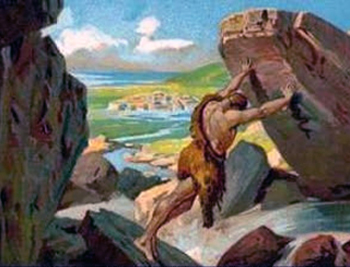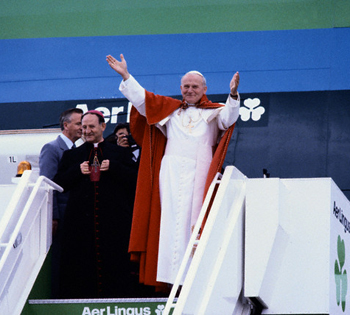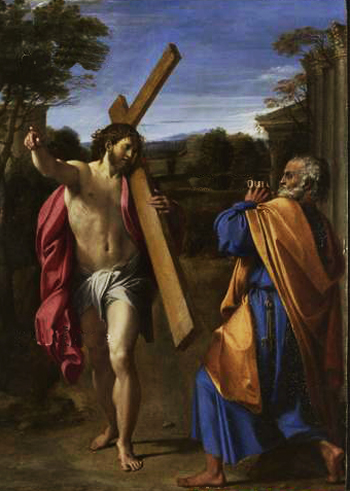Homosexuality and the Clergy
 |
 |
 |
 |
 |
 |
 |
John Paul II & the Augean Stables
In Greek mythology, Hercules, the son of the god Zeus, was the greatest of all the heroes. The goddess Hera caused him to go mad, and in a fit Hercules killed his wife and their three sons. To atone for this terrible deed he was placed under the aegis of Eurystheus, the King of Tiryna, and given 12 “labors” to perform for penance.
His fifth labor was to clean the stables of Augeas, the son of the sun god. This assignment was considered impossible because the stables, which housed thousands of head of cattle, had not been cleaned in over three decades. To clean the filth, Hercules rerouted the Alpheus and Peneus Rivers to pass through the stables, thus cleansing the stables and accomplishing his task.
 This maneuver did more than just clean the stables. The waters that cascaded through the stables also fertilized the surrounding soils, which went on to produce much fruit.
This maneuver did more than just clean the stables. The waters that cascaded through the stables also fertilized the surrounding soils, which went on to produce much fruit.
In a not-surprising statement in a book-interview with Bernard Janzen titled The Shoes of the Fisherman, Fr. Malachi Martin refers to the Augean Stables myth to depict the state of the Church. What is disturbing is that these three interviews took place 20 years ago in 1993 when JPII was at the helm of the Church.
The Pope knew full well what the state of the Church was when he was elected in 1978. He knew of the rampant homosexuality of the priests and Hierarchy, the covering up of clerical sex abuse and shifting of predators, the Satanism that had infiltrated to high levels, the corruption of the Mass, the entrenched silence of the clergy on Hell, penitence, sin, punishment, etc.
“It was a Church in shambles that was handed, like meat on a platter, to John Paul II. And he had a decision to make: ‘Do I take up my axe and cut off heads, expel people, and clean up the Augean stables of their dirt and muck? Do I get rid of my heretical bishops? Do I get rid of these cardinals who do not believe any longer or who are in the pay of foreign governments or are homosexuals or are Satanists? Do I clean the house?’” (1)
 He decided to do nothing. Malachi Martin speciously speculates that JPII reasoned that his inaction was helping the Church in a roundabout way: “If I try to enforce the law, the Church will split into pieces.” (2)
He decided to do nothing. Malachi Martin speciously speculates that JPII reasoned that his inaction was helping the Church in a roundabout way: “If I try to enforce the law, the Church will split into pieces.” (2)
This appears to me more like a cover-up of Fr. Martin for JPII than anything else. In 1978 the ecclesiastical structure was already in pieces, Vatican II being the cause and the effect. Even a simpleton can reason that what would make the Church worse is to let the dung heap continue to pile up, adding layer upon layer until the filth and the stench could no longer be concealed.
Clearly John Paul II purposely played his part in the destruction of the Church. The conciliar Church had the desire to destroy as Atila S. Guimaraes points out in his Collection Eli Eli Lamma Sabacthani?. (3)
Toward that end, instead of ruling like the Monarch he was, John Paul II made the cowardly and indefensible decision to travel so that the world could see and admire him. While the putrescence inside the Church metastasized, his doing nothing smacks of the adage about Nero, who “fiddled while Rome burned.”
And indeed he traveled. The Tablet reports that at that time: “According to statistics released at the Vatican October 14, 2000, the most traveled Pope, John Paul II, has visited 123 countries and made 138 trips within Italy, and 291 visits to Rome.” (4).
While he appeared smiling everywhere, everything got worse. JPII's decision to let the stables get filthier has brought us to a state where what is left of the ecclesiastical structure appears to be only a “façade,” where in its core the destruction continues to worsen by the day. (5)
Let me set out one example. The lid came off the homosexual and pedophilia clergy crisis in Boston in 2002, when it was revealed that institutionalized sexual attacks on young boys and the post facto cover-ups by the Hierarchy were the rule.
This policy was finally traced to the Papacy itself, specifically to a letter authored by John Paul II written May 25, 1999, advising the cover-ups. (6) The financial cost (by 2012 the cost of paying off the victims had reached $3 billion) takes second seat to the suffering of thousands of sodomized victims and the scandal caused for Catholics.
 So, as the most powerful leader on the globe, what should John Paul II have done? The answer is simple. What does Our Lord require of His Vicars? He made it clear from the beginning during the Pontificate of St. Peter, the first Pope.
So, as the most powerful leader on the globe, what should John Paul II have done? The answer is simple. What does Our Lord require of His Vicars? He made it clear from the beginning during the Pontificate of St. Peter, the first Pope.
When the persecutions of the Church in Rome worsened, St. Peter fled, to travel. While he was on the Appian Way Our Lord appeared to him, and told Peter to return to Rome and be crucified there.
Then St. Peter understood his error in fleeing and returned to Rome where he was imprisoned and martyred. His martyrdom had the effect of enlivening the Church, which became the precious institution handed to future generations.
JPII's decision to travel instead of rule resulted in dire consequences for the Church. To say the least, he let the evil multiply inside the ecclesiastical structure.
After him, Benedict XVI continued the same progressivist policies. Now Francis sits in that same Chair in order to destroy the last vestiges of the papal monarchy.
Those powers are the progressivst forces inside the Church that do not want to clean the Augean stables. They are aiming toward her total destruction, were that possible.

His fifth labor was to clean the stables of Augeas, the son of the sun god. This assignment was considered impossible because the stables, which housed thousands of head of cattle, had not been cleaned in over three decades. To clean the filth, Hercules rerouted the Alpheus and Peneus Rivers to pass through the stables, thus cleansing the stables and accomplishing his task.

Hercules reroutes a river to clean the Augean Stables
In a not-surprising statement in a book-interview with Bernard Janzen titled The Shoes of the Fisherman, Fr. Malachi Martin refers to the Augean Stables myth to depict the state of the Church. What is disturbing is that these three interviews took place 20 years ago in 1993 when JPII was at the helm of the Church.
The Pope knew full well what the state of the Church was when he was elected in 1978. He knew of the rampant homosexuality of the priests and Hierarchy, the covering up of clerical sex abuse and shifting of predators, the Satanism that had infiltrated to high levels, the corruption of the Mass, the entrenched silence of the clergy on Hell, penitence, sin, punishment, etc.
“It was a Church in shambles that was handed, like meat on a platter, to John Paul II. And he had a decision to make: ‘Do I take up my axe and cut off heads, expel people, and clean up the Augean stables of their dirt and muck? Do I get rid of my heretical bishops? Do I get rid of these cardinals who do not believe any longer or who are in the pay of foreign governments or are homosexuals or are Satanists? Do I clean the house?’” (1)

JPII, a Pope eager to travel and appear, unconcerned about cleaning the Church
This appears to me more like a cover-up of Fr. Martin for JPII than anything else. In 1978 the ecclesiastical structure was already in pieces, Vatican II being the cause and the effect. Even a simpleton can reason that what would make the Church worse is to let the dung heap continue to pile up, adding layer upon layer until the filth and the stench could no longer be concealed.
Clearly John Paul II purposely played his part in the destruction of the Church. The conciliar Church had the desire to destroy as Atila S. Guimaraes points out in his Collection Eli Eli Lamma Sabacthani?. (3)
Toward that end, instead of ruling like the Monarch he was, John Paul II made the cowardly and indefensible decision to travel so that the world could see and admire him. While the putrescence inside the Church metastasized, his doing nothing smacks of the adage about Nero, who “fiddled while Rome burned.”
And indeed he traveled. The Tablet reports that at that time: “According to statistics released at the Vatican October 14, 2000, the most traveled Pope, John Paul II, has visited 123 countries and made 138 trips within Italy, and 291 visits to Rome.” (4).
While he appeared smiling everywhere, everything got worse. JPII's decision to let the stables get filthier has brought us to a state where what is left of the ecclesiastical structure appears to be only a “façade,” where in its core the destruction continues to worsen by the day. (5)
Let me set out one example. The lid came off the homosexual and pedophilia clergy crisis in Boston in 2002, when it was revealed that institutionalized sexual attacks on young boys and the post facto cover-ups by the Hierarchy were the rule.
This policy was finally traced to the Papacy itself, specifically to a letter authored by John Paul II written May 25, 1999, advising the cover-ups. (6) The financial cost (by 2012 the cost of paying off the victims had reached $3 billion) takes second seat to the suffering of thousands of sodomized victims and the scandal caused for Catholics.

Christ reprimands Peter as he flees from Rome
When the persecutions of the Church in Rome worsened, St. Peter fled, to travel. While he was on the Appian Way Our Lord appeared to him, and told Peter to return to Rome and be crucified there.
Then St. Peter understood his error in fleeing and returned to Rome where he was imprisoned and martyred. His martyrdom had the effect of enlivening the Church, which became the precious institution handed to future generations.
JPII's decision to travel instead of rule resulted in dire consequences for the Church. To say the least, he let the evil multiply inside the ecclesiastical structure.
After him, Benedict XVI continued the same progressivist policies. Now Francis sits in that same Chair in order to destroy the last vestiges of the papal monarchy.
Those powers are the progressivst forces inside the Church that do not want to clean the Augean stables. They are aiming toward her total destruction, were that possible.
- Malachi Martin, The Shoes of the Fiherman, Canada: Triumph Communications, 2013, p. 20;
- Ibid., p. 18;
- Collection authored by Atila Sinke Guimaraes, available through Tradition in Action;
- From “Bird's Eye View of the News,” Atila Sinke Guimaraes, 11-11-2000;
- A.S. Guimaraes, Ecclesia,(Volume XI of Eli, Eli, Lamma Sabacthani?);
- A.S. Guimaraes,”The Papal Letter”.

Posted May 24, 2013
______________________
______________________











